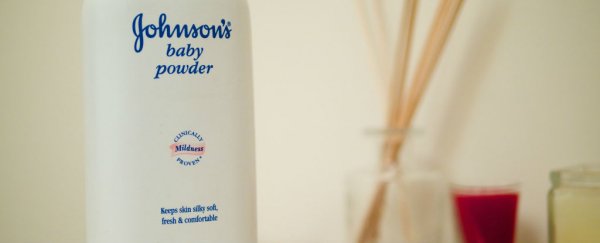A Missouri jury has ordered Johnson & Johnson to pay damages of US$72 million to the family of Jackie Fox, a 62-year-old Alabama woman who died in October 2015, and whose daily baby powder use has been blamed for her terminal ovarian cancer.
The case is part of a larger set of claims that, for decades, Johnson & Johnson has failed to adequately warn its customers of the potential link between talc-based products and certain types of cancer, with around 1,000 more cases having been filed in Missouri state court, and another 200 in New Jersey.
The ruling, which was announced on Monday, concluded a three-week trial, and if it sticks, would set a very dangerous precedent for Johnson & Johnson in the face of all those other claims. But judging by the lack of scientific evidence linking talcum to cancer, the company will likely appeal the verdict with everything it's got.
"Big jury verdicts do tend to be reined in during the course of the appellate process, and I expect that to be the case here," Nora Freeman Engstrom, a Stanford University law professor not involved in the Missouri case, told the Associated Press.
So wtf is going on here, I hear you ask? Good question, because this is all pretty complicated, and here's why.
First off, a couple of the most damning pieces of evidence from Fox's attorney is that, just last year, Johnson & Johnson changed its formulation to eliminate two potentially dangerous chemicals from its personal hygiene products.
"In May 2009, a coalition of groups called the Campaign for Safe Cosmetics began pushing Johnson & Johnson to eliminate questionable ingredients from its baby and adult personal care products. After three years of petitions, negative publicity and a boycott threat, the company agreed in 2012 to eliminate the ingredients 1,4-dioxane and formaldehyde, both considered probable human carcinogens, from all products by 2015."
And then there's an internal memo sent by a Johnson & Johnson medical consultant in September 1997, which the Associated Press reported as saying:
"'[A]nybody who denies [the] risks' between 'hygienic' talc use and ovarian cancer would be publicly perceived in the same light as those who denied a link between smoking cigarettes and cancer: 'Denying the obvious in the face of all evidence to the contrary.'"
Pretty scary, right? But from Johnson & Johnson's perspective, the verdict "goes against decades of sound science proving the safety of talc as a cosmetic ingredient in multiple products", says spokeswoman Carol Goodrich, citing the decades of inconclusive research conducted by the US Food and Drug Administration and National Cancer Institute into the link between talc and cancer.
So what exactly is talc? In its natural form, talcum can sometimes contain asbestos - a known carcinogen. Accordingly, since 1973, all talcum products in the United States have been required by law to only include asbestos-free talcum. But there are still questions as to whether asbestos-free talcum also increases a person's risk of cancer, particularly if it's applied regularly to the genital area over many years, as was the case with Jackie Fox.
A great deal of research has been done to find evidence of a possible link, and the results have so far been frustratingly inconsistent. But here are some notable studies, both for and against the link:
- A study published in 1997 found that women who have used talcum powder or genital deodorant on their perineal area (genital area) were 50-90 percent more likely to develop ovarian cancer. But this study would have included results both before and after the 1973 asbestos regulation.
- A 2003 meta-analysis of 16 studies and 11,933 participants found that talc use was associated with a higher risk of ovarian cancer, but could not find a casual link, and did not find a link between higher doses and an increased risk.
- A 2000 study of 78,630 women found "little support for any substantial association between perineal talc use and ovarian cancer risk overall; however, perineal talc use may modestly increase the risk of invasive serous ovarian cancer".
- A 2010 study of 66,028 women suggested that "perineal talcum powder use increases the risk of endometrial cancer, particularly among postmenopausal women".
- A 2014 study that followed 61,576 postmenapausal women for over 12 years found that "perineal powder use does not appear to influence ovarian cancer risk".
Based on the inconsistent evidence and lack of causal relationships between talc and cancer, the International Agency for Research on Cancer (IARC) - part of the World Health Organisation - classifies talc-based body powders applied to the genital area as "possibly carcinogenic" to humans, and inhaled talc not containing asbestos as "not classifiable as to carcinogenicity in humans".
You also have to consider the problems associated with the IARC's own classification system, which you can read about here.
Until more evidence comes to light, the question now is should companies be forced to warn customers about potentially carcinogenic chemicals in their products? The jury on Jackie Fox's case appeared to think so. "This case clearly was a bellwether, and clearly the jury has seen the evidence and found it compelling," Freeman Engstrom told the Associated Press. "[T]he jury was distressed by the company's conduct."
